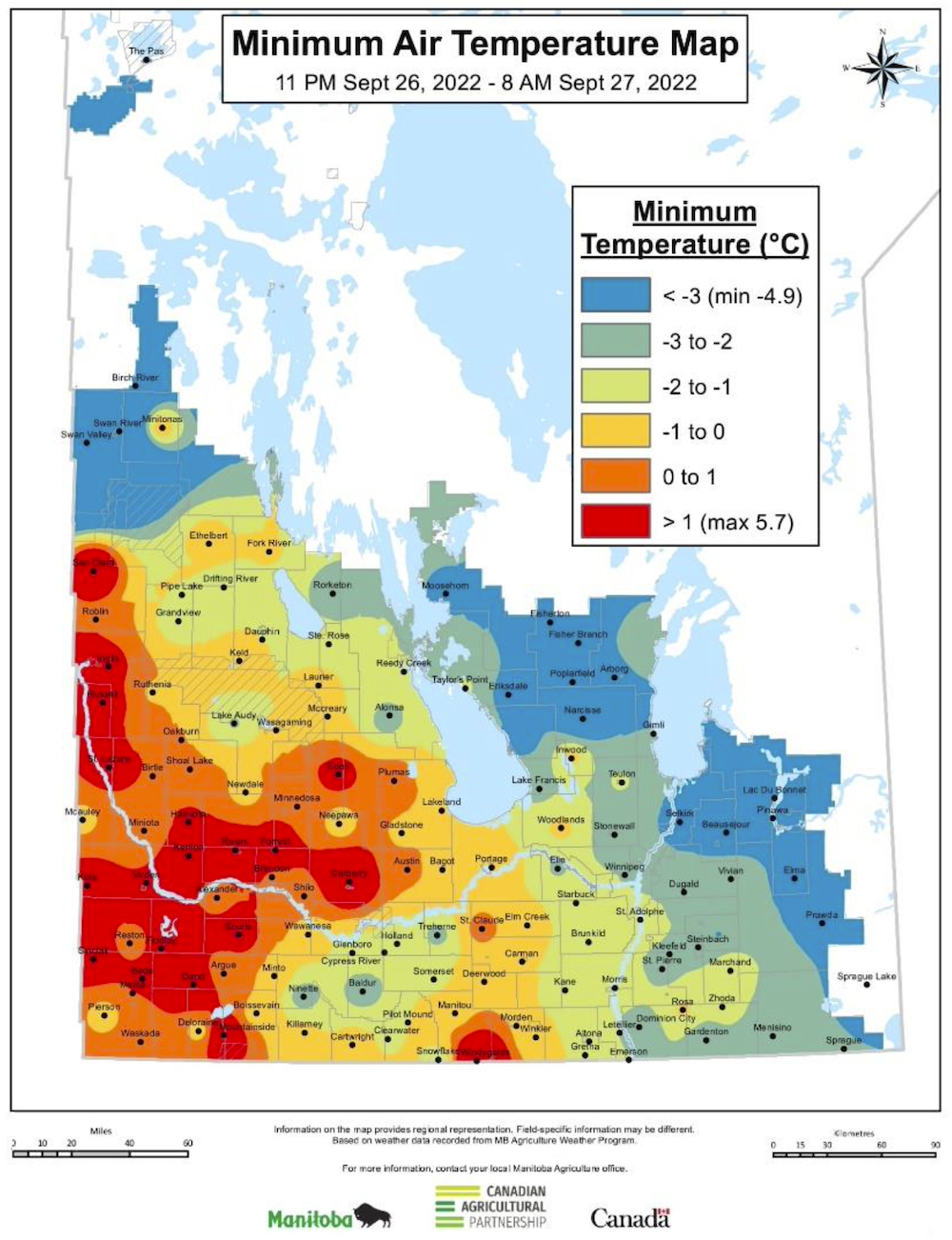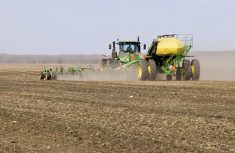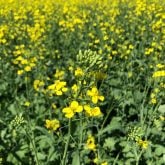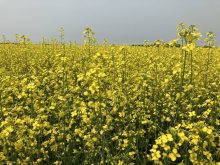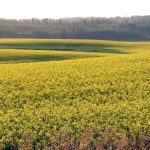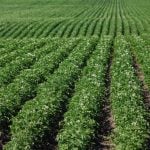Overview
Harvest progress sits at 47 per cent completed across the province, approximately 3.5 weeks behind the 5-year average of 79 per cent complete by week 39.
Few crops were harvested last week until the weekend, since frequent drizzling rains, high humidity, and overcast conditions prevented harvest operations. Crops that were harvested before the start of this week were often tough to damp, and had to be artificially dried.
Read Also

A place of national honour for former deputy ag minister, Dori Gingera-Beauchemin
Long public service, focus on community and industry leadership launch Dori Gingera-Beauchemin into 2025 Canadian Agricultural Hall of Fame honourees
Killing frosts arrived in much of the western side of the province on the morning of September 22 and much of the rest province saw frost on September 27. Some crop injury is expected in green canola and soybeans, but damage is expected to be relatively light.
Soft field surfaces have shown more compaction and tracking from machinery than fields combined earlier in the month, and farmers are making frequent header adjustments to align with soil conditions to reduce earth tag in soybeans.
Unharvested cereals have seen some bleaching and staining from recent wet weather, especially where they lie in swath. Quality downgrades are expected in the northern parts of the Eastern, Southwest and Interlake regions.
Some soybean crops may be harvested ahead of some cereals and canola this year as farms wait for grain moisture content to drop in those crops.
Light frosts have producers concerned over nitrates in their annual crop silage and greenfeed still standing, and are advised to feed test their annual crops for nitrates prior to feeding.
Manitoba Agricultural Services Corporation (MASC) has published the 2022 Variety Market Share Report.
Cereals
Winter cereal grains
Seeding fall rye and winter wheat has started, primarily on canola stubble. Seedbed conditions are good, and recent rains have promoted good emergence and growth.
The full coverage MASC deadline for winter cereal seeding passed on September 25, and extended seeding deadline is approaching on September 30.
Last year’s winter wheat variety breakdown shows Emerson holding 36 per cent of the market share, followed by AAC Wildfire (28 per cent) and AAC Gateway (16 per cent).
Spring cereal grains
Remaining unharvested wheat and oats did not dry quickly following the rains last week, and farms were forced to use artificial drying to condition grain for storage if they were able to harvest at all. Wheat moisture ranged from 15 to 17 per cent, while straight-cut oats had moisture levels between 13 to 15 per cent.
Bleaching and weathering on unharvested wheat is noticeable on fields in the Southwest, as unharvested cereal acres increase moving northward to Riding Mountain National Park.
Spring cereal harvest was at a near-standstill last week, resuming on standing crops over the weekend. Swathed cereals remain on the field.
Wheat yield averages are reported between 60 to 70 bu/acre across the province, but higher near Swan Valley and Roblin, between 75 to 90 bu/acre.
Barley yield averages are reported between 50 to 100 bu/acre, varying widely by seeding date and rainfall.
Oat yield averages are reported between 120 to 130 bu/acre, with some regional differences.
Remaining oat crops are mostly swathed. Some quality downgrading is expected.
Corn
Corn development has reached R5 (dent) stage, with the milk line moving down the kernel, and black layer starting to form, depending on hybrid.
Light frosts crisped upper leaves in corn crops; no grain damaged noticed in the Central region. Seed moisture is generally between 30 to 40 per cent.
Oilseeds
Canola
Canola harvest has progressed slowly across the province, as a result of wet weather, short drying days and early sunsets stopping harvest when canola does not feed smoothly into harvesting equipment.
Direct-cut canola has been combined between 8 to 17 per cent moisture, some crops were dried, and others are waiting for warmer and drier days this week to resume harvest.
Average yields vary, typically in the mid-40bu/acre range in the Southwest, and trending higher in the Central region to the low fifties. In the Northwest, early yields are below average, between 35 to 45 bu/acre, but expected to increase slightly.
Interlake canola yields have been disappointing for many, average yield is approximately 30 bu/ac in the Arborg area, and slightly below expectations at 40 bu/ac in the southern portion of region.
Producers continue to swath later-seeded canola to speed drydown in the Southwest and towards Lake Manitoba.
Flax & sunflowers
Many flax crops are now in swath; the remainder of the crop is standing for direct harvest.
Sunflowers are in the R8 to R9 stages, desiccation has started on some crops, while others may use natural desiccation with the arrival of recent frosts to advance crop drydown.
Pulses
Most soybean fields have turned colour, leaf drop is widespread on crops planted before the beginning of June and has mostly moved past the risk of frost damage.
Later-planted crops still have green leaves, but will now drop them since frost has arrived.
Many parts of the Central region have seen a good start to soybean harvest, early yield reports are
between 40 to 50 bu/acre.
Dry bean harvest is well underway, approaching 75% complete. Very good yields reported, with many
bean classes yielding between 2,000 to 3,000 lbs/acre.
The record average yield for dry beans in Manitoba was set in 2017 at just over 2,100 lbs/acre, and dry
bean crops could exceed that mark this year.
Forages & livestock
Forages
Light frosts have producers concerned over nitrates in their annual crop silage and greenfeed still standing, and are advised to feed test their annual crops for nitrates prior to feeding.
Second-cut alfalfa yields are between 0.5 to 1 US short ton per acre, and producers are contemplating taking a third or even fourth cut after the killing frost if good drying conditions arrive.
Corn silage harvest is underway in many areas, tonnage appears to be good.
Cattle producers are frustrated with soft ground conditions, and will attempt to move bales back to storage yards in the coming days.
Livestock
Grass pasture growth has benefitted from cooler conditions and recent rain, putting on enough growth in many areas to sustain fall grazing.
Dugouts and sloughs are at 70 per cent capacity.
Livestock water supplies on pasture are dropping, but remain sufficient to complete the grazing season in all parts of the province.
Fall cattle roundup from community pastures has begun; mostly yearlings and earlier calves are moving to the auction marts at this time.
Regional comments
Southwest
Little to no harvest progress occurred during the previous week, as continued showers and wet conditions kept producers out of the field until Sunday. Frost arrived in the region over several nights in the previous seven days, but was generally light. Frost damage on crops appears minimal, as most crops had matured enough to withstand freezing temperatures. Winter cereals have benefitted from recent rains, and good growth is evident on those fields. A few unharvested pea fields remain, and producers are finding it challenging to clean up unharvested patches with soft and wet ground conditions. Harvest is more advanced south of the TransCanada, while moving northward has fewer cereal and canola crops in the bin.
Northwest
Another slow week of harvest progress dictated by showers (up to 32 mm at The Pas) and cool, humid days. Some harvest was able to resume by Saturday, and widespread on Sunday. The heaviest frosts touched down Thursday morning at Ruthenia, Inglis, and Grandview; down to -2.5 C for several hours. With a favourable forecast, it is expected that good progress should be made this week, but the narrow harvest window may be affected by heavy morning dew and tough grain conditions by evening.
Central
Wet, humid, and overcast conditions with little wind prevented any substantial harvest progress across the region this past week. Frequent drizzling rains prevented any new harvest activity, and forced farms to artificially dry grain they were able to combine during that time. Conditions improved towards the weekend, with a resumption of harvest on Saturday and Sunday, primarily in canola and soybeans. Some fall tillage has been completed, and green regrowth is now noticeable on harrowed cereal stubble. A few producers have begun applying anhydrous ammonia and/or granular fertilizer ahead of the 2023 crop. Soil temperatures remain above 10 C in all parts of the Central region, ranging from 10.7 to 13.3 C at 5 cm depth.
Eastern
Rainfall occurred over several days last week, followed by frost on three separate days in the northern districts of the region. Frost on Monday morning resulted in damage to corn leaves and upper stalks, as well as the top 10 to 15 cm of soybean plants. Late-maturing soybeans are showing extensive leaf damage, and crops are now terminated. Seed damage is being assessed. Further south, frost duration was shorter, and crop growth termination may not be as severe. Virtually zero harvest was completed in the region over the previous seven days, and resumed on Monday as sunny and dry weather arrived. Some elevators have reported receiving tough canola in order to meet demand, and farmers are using artificial drying to reduce moisture in cereals and canola.
Interlake
Last week had no harvest activity due to wet and overcast conditions. Harvest activity is expected to pick up this week, given the sunny and windy forecast. Frost was reported in the region on Thursday morning, ranging from a very light frost in the southern Interlake, down to -2 C for several hours in the northern parts of the region. Many crops remain green and are not yet ready for harvest. Farms in the northern Interlake are concerned about frost damage on canola, soybeans and corn.





